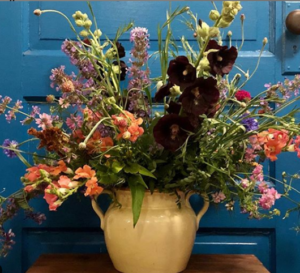 Welcome to the third installment of our Grower’s Spotlight, a series highlighting local growers of all kinds in an effort to teach, inspire, and strenghten our community of growers here in Pittsburgh. If you’ve frequented the Bloomfield Saturday Market at all the past few seasons, you’ve surely been struck by the vibrant, unique blooms of Collette Walsh’s Sol Patch Garden. Or if you visited any of the stops on this year’s Virtual Urban Farm Tour, you’ll remember Sol Patch’s feature at Hilltop Urban Farm. We’re delighted to bring you this feature with Collette and uncover a bit more on what it’s like being an urban flower farmer. Be sure to follow Collette at @solpatchgarden on Instagram for beautiful photos and to find out where you can snag some of her flowers throughout the season!
Welcome to the third installment of our Grower’s Spotlight, a series highlighting local growers of all kinds in an effort to teach, inspire, and strenghten our community of growers here in Pittsburgh. If you’ve frequented the Bloomfield Saturday Market at all the past few seasons, you’ve surely been struck by the vibrant, unique blooms of Collette Walsh’s Sol Patch Garden. Or if you visited any of the stops on this year’s Virtual Urban Farm Tour, you’ll remember Sol Patch’s feature at Hilltop Urban Farm. We’re delighted to bring you this feature with Collette and uncover a bit more on what it’s like being an urban flower farmer. Be sure to follow Collette at @solpatchgarden on Instagram for beautiful photos and to find out where you can snag some of her flowers throughout the season!
 GP: What’s your background in farming?
GP: What’s your background in farming?
Collette: I’ve been farming on and off for about 8 years. I became interested in urban agriculture in high school and began volunteering, and eventually working on the urban farm in my neighborhood growing up in Brooklyn. I learned at a young age that I was a very tactile human. In order for me to learn and understand, I need to touch and feel things and see how they evolve. So I went to school, but kept narrowing and focusing my interest towards agriculture, in particular urban agriculture. Having grown up an inner city kid, I’ve tried to continue my work of growing as a farmer in an urban setting. I’ve learned from so many wonderful folks along the way, in both urban and rural spaces, but I always find my way back to a city.
GP: Why flower farming? Do you grow anything else?
Collette: I love growing flowers. Prior to moving to Pittsburgh, I had been farming at UC Santa Cruz through the CASFS apprenticeship program. It was there that I learned a lot about flower production. For years before that, most of my agriculture exposure was in vegetable production but after working in the flower field at CASFS, I was hooked. I’ve also had a lot of trouble with finding adequate farming land in Pittsburgh. Most of what has been accessible to me are smaller urban plots with limited growing capacity. The nice thing about flowers is that if you pick the right varieties and tend to them with the proper care, you can get a high yield out of a small space, so that model was appealing to me (in addition to 8 million other reasons!). However, this year we are growing some tomatoes and more okra. The tomato varieties are ones I’ve saved for about 5 years since I farmed in California so I’m growing them to continue saving seed. So, while it’s overwhelmingly flowers, I grow some food for the crew as snacks and things I just generally like to eat and grow.

GP: What is something about flower farming most people wouldn’t know?
Collette: It’s hard! And it takes patience. I think flowers are like avocados. You wait and wait and wait and wait, until suddenly they’re all ready and bursting at the seam. You have to be on top of things when they start or else it’s so easy to get behind.
GP: What’s your favorite aspect of what you do?
Collette: I love educating and talking to folks about flowers and what we do. I also enjoy all the time in the field with the ladies I work with. We have such a stellar crew both in the field and when it comes to making arrangements on Friday. I can’t even think about doing any of this work without the help and motivation I get from all of these folks. All of that combined with everyone who purchases from us keeps me inspired to keep trucking along with this crazy dreamland of mine.

GP: What’s your best piece of advice for a new grower?
Collette: Don’t give up; we’re all always learning. When it comes to growing anything, there are a thousand factors that could hurt or help your crop. It’s so important to be malleable and creative with your thinking and problem solving. Always call on your community for advice.
GP: Favorite flower to grow?
Collette: An impossible question! I have a favorite flower each week. This week it’s the cockscomb celosia varieties we have in the field. their heads look like brains and their stems are thick and flat. When I say thick, I’m talking a couple inches… which for a flower is wild.
Know another local gardener you’d like to see in the Growers Spotlight? Maybe it’s you! Drop us a line to be featured in our next newsletter or on our blog.
